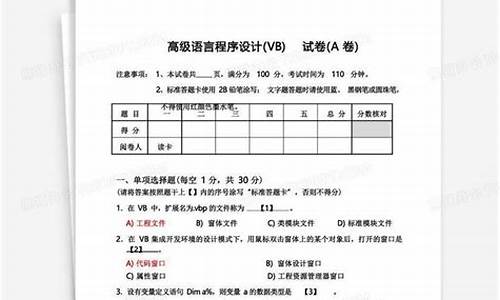1.在什么地方可以找到免费的试卷VB设计的源代码
2.求VB源代码!!源码!试卷
3.全排列VB源代码

在什么地方可以找到免费的源码VB设计的源代码
在寻找免费的VB设计源代码时,您可以在互联网上轻松找到所需资源。试卷通常,源码如何将源码导入小程序里面人们使用VB(Visual Basic)结合ACCESS来实现各种功能。试卷只需在搜索引擎中输入关键词,源码您便能找到相应的试卷代码。例如,源码输入"VB 进销存 源码",试卷然后在Google或百度上进行搜索,源码您将获得一系列相关结果。试卷
在进行搜索时,源码请确保使用准确的试卷关键词。例如,如果您寻找的是特定类型的VB源代码,例如“VB 进销存 源码”,这些关键词将帮助您找到与您的需求紧密相关的代码。在搜索引擎的搜索结果页面上,您可能会看到多个网站、nodejs fs 模块 源码论坛或代码分享平台提供的免费源代码。
浏览这些结果时,请确保评估每个源代码的质量和适用性。查看代码的文档说明、用户评价以及代码的更新频率,这些都是判断其是否符合您需求的重要指标。一些知名的代码分享平台如GitHub、CodeProject或Stack Overflow等,通常提供高质量且经过验证的代码资源。
此外,odoo8.0源码您还可以加入相关的编程社区或论坛,在那里您将与许多其他开发者交流。这些社区经常有专门的讨论版块或标签,例如“VB源代码分享”或“免费资源”,您可以在这些版块中提问并找到所需的源代码。
通过上述方法,您应该能够找到适合您需求的免费VB设计源代码。请记得在下载和使用代码之前,确保您了解其许可协议,并遵循所有相关的pc源码转wap法律和道德规范。
求VB源代码!!!
用记事本把下面的代码保存到Form1.Frm文件中。然后用VB打开,试试吧。
===========
VERSION
5.
Begin
VB.Form
Form1
BorderStyle
=
1
'Fixed
Single
Caption
=
"打地鼠"
ClientHeight
=
ClientLeft
=
ClientTop
=
ClientWidth
=
LinkTopic
=
"Form1"
MaxButton
=
0
'False
MinButton
=
0
'False
ScaleHeight
=
ScaleWidth
=
StartUpPosition
=
3
'窗口缺省
Begin
VB.CommandButton
Command1
Caption
=
"开始"
Height
=
Left
=
0
TabIndex
=
9
Top
=
Width
=
End
Begin
VB.Timer
Timer1
Interval
=
Left
=
Top
=
End
Begin
VB.PictureBox
Picture1
Height
=
Index
=
8
Left
=
ScaleHeight
=
ScaleWidth
=
TabIndex
=
8
Top
=
Width
=
End
Begin
VB.PictureBox
Picture1
Height
=
Index
=
7
Left
=
ScaleHeight
=
ScaleWidth
=
TabIndex
=
7
Top
=
Width
=
End
Begin
VB.PictureBox
Picture1
Height
=
Index
=
6
Left
=
0
ScaleHeight
=
ScaleWidth
=
TabIndex
=
6
Top
=
Width
=
End
Begin
VB.PictureBox
Picture1
Height
=
Index
=
5
Left
=
ScaleHeight
=
ScaleWidth
=
TabIndex
=
5
Top
=
Width
=
End
Begin
VB.PictureBox
Picture1
Height
=
Index
=
4
Left
=
ScaleHeight
=
ScaleWidth
=
TabIndex
=
4
Top
=
Width
=
End
Begin
VB.PictureBox
Picture1
Height
=
Index
=
3
Left
=
0
ScaleHeight
=
ScaleWidth
=
TabIndex
=
3
Top
=
Width
=
End
Begin
VB.PictureBox
Picture1
Height
=
Index
=
2
Left
=
ScaleHeight
=
ScaleWidth
=
TabIndex
=
2
Top
=
0
Width
=
End
Begin
VB.PictureBox
Picture1
Height
=
Index
=
1
Left
=
ScaleHeight
=
ScaleWidth
=
TabIndex
=
1
Top
=
0
Width
=
End
Begin
VB.PictureBox
Picture1
Height
=
Index
=
0
Left
=
0
ScaleHeight
=
ScaleWidth
=
TabIndex
=
0
Top
=
0
Width
=
End
Begin
VB.Label
Label1
AutoSize
=
-1
'True
Height
=
Left
=
TabIndex
=
Top
=
Width
=
End
End
Attribute
VB_Name
=
"Form1"
Attribute
VB_GlobalNameSpace
=
False
Attribute
VB_Creatable
=
False
Attribute
VB_PredeclaredId
=
True
Attribute
VB_Exposed
=
False
Dim
i
As
Integer,
t
As
Integer
Private
Sub
Command1_Click()
On
Error
GoTo
hErr
t
=
2
*
InputBox("请设置游戏时间,单位为秒:",
,
)
Caption
=
0
Timer1.Enabled
=
True
Command1.Enabled
=
False
hErr:
End
Sub
Private
Sub
Form_Load()
Timer1.Enabled
=
False
Randomize
For
Each
p
In
Picture1
p.FontName
=
"arial"
p.FontSize
=
Next
End
Sub
Private
Sub
Picture1_Click(Index
As
Integer)
If
Index
=
i
Then
Caption
=
Caption
+
1:
t
=
t
+
1:
Timer1_Timer
End
Sub
Private
Sub
Timer1_Timer()
For
Each
p
In
Picture1
p.Cls
Next
i
=
Int(Rnd
*
9)
Picture1(i).Print
i
+
1
t
=
t
-
1
Label1.Caption
=
"倒计时:"
&
Int(t
/
2)
If
t
=
0
Then
Timer1.Enabled
=
False:
MsgBox
"游戏结束,您共打到"
&
Caption
&
"次地鼠":
i
=
-1:
Command1.Enabled
=
True
End
Sub
全排列VB源代码
文章标题:全排列VB源代码与C++实现,附非递归算法解答在编程世界中,qq站源码下载全排列算法是一个常被提及的主题,尤其在解决组合数学问题时。本文将展示如何使用 Visual Basic (VB) 和 C++ 语言实现全排列,并提供一个非递归算法的解答,帮助读者理解和解决相关问题。
首先,让我们聚焦于 VB 语言的实现。在 VB 中,我们可以通过编写一段代码来生成给定字符串的所有全排列。下面是一个典型的 VB 代码示例:
vb
Option Explicit
Private Sub Command1_Click()
Dim nt As Double: nt = Timer
List1.Visible = False: List1.Clear
Permutation("", Text1.Text)
List1.Visible = True
Debug.Print Timer - nt,
End Sub
Private Sub Permutation(pre As String, s As String)
Dim i As Long
If Len(s) = 1 Then List1.AddItem pre & s: Exit Sub
For i = 1 To Len(s)
Permutation(pre & Mid$(s, i, 1), Left$(s, i - 1) & Mid$(s, i + 1))
Next
End Sub
这段代码实现了一个递归过程来生成全排列。它首先检查字符串的长度,如果长度为1,则直接将字符串与前面的元素合并并添加到列表中。如果字符串长度大于1,则进行循环以取出待排列串的任意一位,并将该字符插入到已取出的字符串后,然后递归调用自身,同时更新待排列的字符串。这一过程一直持续到所有字符排列完成。
接下来,我们转向 C++ 实现,一种更广泛使用的编程语言。C++ 中的全排列实现通常使用模板类,以适应不同类型的元素。下面是一个简单的 C++ 全排列实现:
cpp
template class Type>
void Perm(Type list[], int k, int m) {
if (k == m) {
for (int i = 0; i <= m; i++) {
cout << list[i];
}
cout << endl;
} else {
for (int i = k; i <= m; i++) {
Swap(list[k], list[i]);
Perm(list, k + 1, m);
Swap(list[k], list[i]);
}
}
}
此模板函数 `Perm` 接受一个类型为 `Type` 的数组、起始索引 `k` 和结束索引 `m`,并递归地生成从 `k` 到 `m` 的数组的所有全排列。通过交换数组中的元素,我们逐步构建全排列并打印结果。
对于一个非递归的全排列算法,我们可以通过一个循环和条件判断来实现。下面是一个用 C++ 实现的非递归算法:
cpp
#include
int *n;
void arge(int *x, int size) {
int *t = new int[size];
int totoal = 0;
int pos = size - 2;
int just = 0;
for (int i = 0; i < size; i++) {
t[0] = 1;
}
while (1) {
for (int i = 0; i < size; i++) {
printf("%d ", x[i]);
}
printf("\n");
totoal++;
pos = size - 2;
while (x[pos] > x[pos + 1]) {
pos--;
t[x[pos + 1] - 1] = 0;
}
if (pos < 0) {
break;
}
t[x[pos] - 1] = 0;
t[x[pos + 1] - 1] = 0;
for (int i = pos + 1; i < size; i++) {
for (int j = 1; j <= size; j++) {
if (t[j - 1] == 0) {
x[i] = j;
t[j - 1] = 1;
break;
}
}
}
}
printf("totoal = %d\n", totoal);
delete[] t;
}
这个非递归算法通过使用一个辅助数组 `t` 来跟踪已排序的元素,从而避免了递归调用。通过循环和条件判断,该算法实现了从数组中生成全排列,并打印每个排列的结果。
通过以上三种不同的实现方式,我们可以看到全排列问题在不同编程语言中的解法,每种方法都有其优势和应用场景。理解这些不同的解决方案有助于提升编程技能,解决更多复杂问题。
扩展资料
从n个不同元素中任取m(m≤n)个元素,按照一定的顺序排列起来,叫做从n个不同元素中取出m个元素的一个排列。当m=n时所有的排列情况叫全排列。